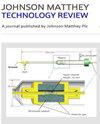Dependence of Mechanical Properties of Platinum-Rhodium Binary Alloys on Valence Electron Parameters
IF 2
4区 化学
Q4 CHEMISTRY, PHYSICAL
引用次数: 0
Abstract
Dependence of mechanical properties of binary Pt-Rh alloys on valence electron ratio (VER), number valence electrons (ev), and average atomic number of the alloys (Z) are investigated. The alloys have high number of valence electrons (9 ≤ ev ≤ 10) and a wide range of the average atomic number (Z = 45–78). Clear correlations between VER of the alloys and their mechanical properties are found. By increasing the VER of the alloy from 0.13 to 0.20 following the increase of Rh content in the composition, the hardness, elastic modulus, and ultimate tensile strength of the alloy increases. Creep rates of the selected alloys clearly decrease with increasing VER at high temperatures (1500-1700 ℃C), whilst stress rupture time at different temperatures consistently increases because of higher Rh content in the alloy solid solution chemistry. Dependence of mechanical properties on valence electron parameters is discussed with reference to the atomic bonding.铂铑二元合金力学性能与价电子参数的关系
研究了二元Pt-Rh合金的力学性能与合金的价电子比(VER)、价电子数(ev)和平均原子序数(Z)的关系。该合金具有较高的价电子数(9≤ev≤10)和较宽的平均原子序数范围(Z = 45 ~ 78)。发现合金的VER与其力学性能之间存在明显的相关性。随着成分中Rh含量的增加,合金的VER由0.13提高到0.20,合金的硬度、弹性模量和极限抗拉强度均有所提高。在高温下(1500 ~ 1700℃),随VER的增加,合金的蠕变速率明显降低,而合金固溶体化学中Rh含量的增加使合金在不同温度下的应力破裂时间持续增加。从原子成键的角度讨论了价电子参数对力学性能的影响。
本文章由计算机程序翻译,如有差异,请以英文原文为准。
求助全文
约1分钟内获得全文
求助全文
来源期刊

Johnson Matthey Technology Review
CHEMISTRY, PHYSICAL-
CiteScore
4.30
自引率
4.30%
发文量
48
审稿时长
12 weeks
期刊介绍:
Johnson Matthey Technology Review publishes articles, reviews and short reports on science enabling cleaner air, good health and efficient use of natural resources. Areas of application and fundamental science will be considered in the fields of:Advanced materials[...]Catalysis[...][...]Characterisation[...]Electrochemistry[...]Emissions control[...]Fine and speciality chemicals[...]Historical[...]Industrial processes[...]Materials and metallurgy[...]Modelling[...]PGM and specialist metallurgy[...]Pharmaceutical and medical science[...]Surface chemistry and coatings[...]Sustainable technologies.
 求助内容:
求助内容: 应助结果提醒方式:
应助结果提醒方式:


